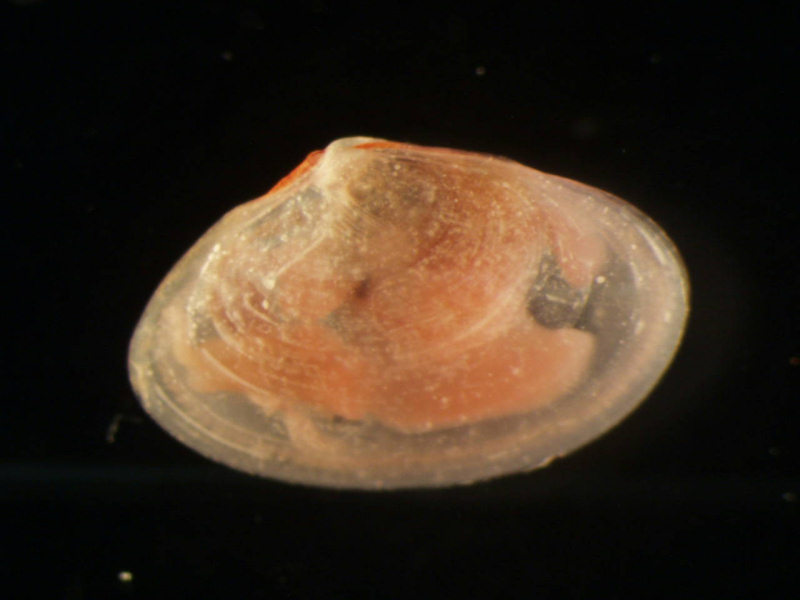Glossy furrow shell (Abra nitida)
Distribution data supplied by the Ocean Biodiversity Information System (OBIS). To interrogate UK data visit the NBN Atlas.Map Help
| Researched by | Saskiya Richards | Refereed by | This information is not refereed |
| Authority | (O. F. Müller, 1776) | ||
| Other common names | Shiny abra | Synonyms | - |
Summary
Description
Abra nitida has an oval-shaped shell of two valves (halves) that are of the same shape and size and up to 2 cm in length and 1.2 cm in height. The valves are asymmetrical with the tip of the valves (beak) positioned behind the dorso-ventral mid-line and pointing inwards towards the valves and to the posterior. The shell is brittle to the touch and the surface bears microscopic concentric lines. The external shell surface is a glossy, pearly white, sometimes translucent and is scattered with minute flecks. The interior surface of the hinge is marked with a spoon-shaped pit (chondrophore) near the beak. An indentation is present towards the posterior of the inner hinge as well as adductor muscle scars that are longer and thinner in the anterior region than in the posterior region. The interior of each valve is glossy and translucent in appearance. The right valve bears 2 small, teeth projecting from the hinge and 2 more teeth that are either side of the hinge whereas the left valve bears 1 tooth from the hinge and 2 weaker teeth, again either side of the hinge. The body is simple, bearing a wedge-shaped foot and two very long siphons.
Recorded distribution in Britain and Ireland
Abra nitida is widespread on the coasts of Britain but less common on the western coast of Ireland.
Global distribution
-Habitat
Abra nitida inhabits self-made burrows in mud, sandy mud, silty sand and muddy gravel in the sublittoral zone to 183 metres.
Depth range
-Identifying features
- Oval-shaped shell consisting of two identically sized and shaped valves.
- Valves asymmetrical.
- Tip of valves point inwards towards the posterior and lies is behind the dorso-ventral mid-line.
- Shell up to 2 cm in length and 1.2 cm in height.
- Shell bears microscopic concentric lines.
- Shell is usually coloured a glossy, pearly white but may be translucent.
- Right valve with two teeth projecting from hinge, left valve with one tooth.
- Body bears two very long siphons.
Additional information
Abra nitida is similar to both Abra alba, that is larger and less elongate, and Abra prismatica, that is not quite as oval. Abra nitida mainly feeds on detritus.
Listed by
- none -
Bibliography
Christensen, J.M., 1980. Seashells. Bivalves of the British and Northern European Seas. Revised and adapted by Peter S. Dance. Hamondsworth: Penguin Books Ltd.
Gibson, R., Hextall, B. & Rogers, A., 2001. Photographic guide to the sea and seashore life of Britain and north-west Europe. Oxford: Oxford University Press.
Hayward, P.J. & Ryland, J.S. (ed.) 1995b. Handbook of the marine fauna of North-West Europe. Oxford: Oxford University Press.
MBA (Marine Biological Association), 1957. Plymouth Marine Fauna. Plymouth: Marine Biological Association of the United Kingdom.
Tebble, N., 1976. British Bivalve Seashells. A Handbook for Identification, 2nd ed. Edinburgh: British Museum (Natural History), Her Majesty's Stationary Office.
Zenetos, A., 1996. The marine Bivalvia (Mollusca) of Greece. Athens: National Centre for Marine Research.
Datasets
Centre for Environmental Data and Recording, 2018. Ulster Museum Marine Surveys of Northern Ireland Coastal Waters. Occurrence dataset https://www.nmni.com/CEDaR/CEDaR-Centre-for-Environmental-Data-and-Recording.aspx accessed via NBNAtlas.org on 2018-09-25.
Conchological Society of Great Britain & Ireland, 2018. Mollusc (marine) data for Great Britain and Ireland - restricted access. Occurrence dataset: https://doi.org/10.15468/4bsawx accessed via GBIF.org on 2018-09-25.
Conchological Society of Great Britain & Ireland, 2023. Mollusc (marine) records for Great Britain and Ireland. Occurrence dataset: https://doi.org/10.15468/aurwcz accessed via GBIF.org on 2024-09-27.
Conchological Society of Great Britain & Ireland, 2023. Mollusc (marine) records for Great Britain and Ireland. Occurrence dataset: https://doi.org/10.15468/aurwcz accessed via GBIF.org on 2024-09-27.
Environmental Records Information Centre North East, 2018. ERIC NE Combined dataset to 2017. Occurrence dataset: http://www.ericnortheast.org.ukl accessed via NBNAtlas.org on 2018-09-38
Merseyside BioBank., 2018. Merseyside BioBank (unverified). Occurrence dataset: https://doi.org/10.15468/iou2ld accessed via GBIF.org on 2018-10-01.
NBN (National Biodiversity Network) Atlas. Available from: https://www.nbnatlas.org.
OBIS (Ocean Biodiversity Information System), 2025. Global map of species distribution using gridded data. Available from: Ocean Biogeographic Information System. www.iobis.org. Accessed: 2025-07-31
South East Wales Biodiversity Records Centre, 2018. SEWBReC Molluscs (South East Wales). Occurrence dataset: https://doi.org/10.15468/jos5ga accessed via GBIF.org on 2018-10-02.
Citation
This review can be cited as:
Last Updated: 01/08/2007
- Bivalve
- Mollusc
- Abra




